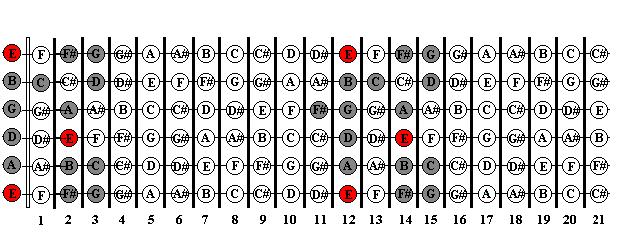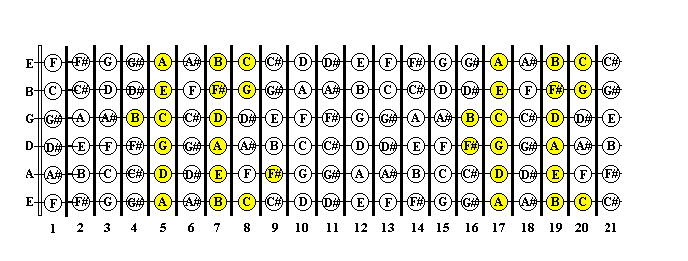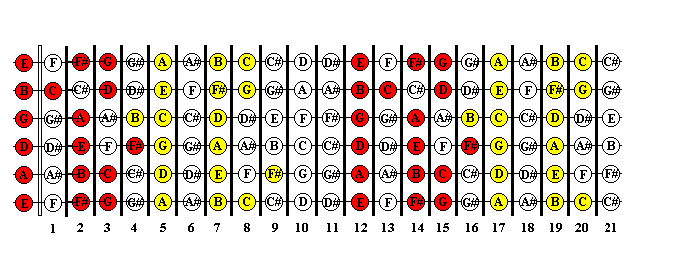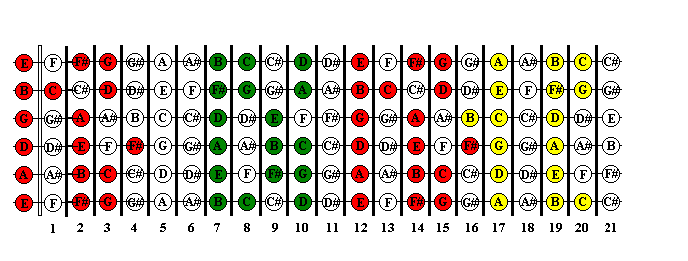Includes Over 150 online guitar lessons

Welcome to Guitar Secrets
Guitar lessons that work!
[C major modes intro] [ C Ionian ] [ Dorian mode ] [ Phrygian mode ] [ Lydian mode ] [ Mixolydian Mode ] [ Aeolian mode ] [ Locrian mode ]
[ Basic major scale fingerings ] [ F major modes ] [ G Modes ] [ Constructing Scales ] [ Key Signatures and constructing major scales ] [ Modulation, cadence, progressions ]
Guitar modes in G major and playing lead guitar
This topic covers using the guitar modes from the key of G major. Also using the E Aeolian mode at the 12th fret.
The question was, do I have to play from E to E if I am playing the E Aeolian mode? The answer is no. What’s important is that you know the E Aeolian mode is from E to E in G major. You can now visualize the notes of that mode. When you play the notes of the E Aeolian mode, you are playing the minor mode in G major. The notes and chords of E Aeolian are Em F# dim, G major, Am, Bm, C major, D major and Em. If you were playing over the Em chord, yes you would want to start with the E note or even a note of the Em chord. If you were playing a G chord, then maybe start with the G note or F# note, which is the leading tone for the key of G major. But, it’s always a good idea to just improvise and experiment.
The E Aeolian mode has the notes E, F#, G, A, B, C, D, E
In the key of G, there are 3 minor chords Am, Bm and Em.
The G, C and D are major chords. The F# is the diminished chord.
The notes and chords in the key of G major are: G Am, Bm, C, D, Em F# dim and G
One way to think about the Aeolian mode is to consider the Aeolian mode and Ionian mode the same. This is because they share the same key signature.
One of the most popular positions to play the E Aeolian mode is at the 12th fret of the guitar. The two most popular minor modes in rock music are the Aeolian and Dorian modes. The Mixolydian is a popular major mode, but with a bit of alteration.
If you were playing the Am chord, you could start with the A note or a note of that chord, but just remember all the notes A to A in that mode, or the A Dorian mode in G major. It is just important to visualize each of the modes as separated entities, but to incorporate them as one. They are just a continuation of each other. All the modes come from the same family. Since you want to play the Aeolian mode, it is the Em mode in G major. So you will base your song in Em. Play at the 12th fret and become accustomed to that location. Just remember, you can play this mode all over the fretboard. Once you learn them as illustrated, it will be easier to move each mode around to different locations. You can learn to play lead guitar in one location and play over all of the chords of that key. But you can also move to different positions of the fretboard to play the same notes.
For example, if you record an E5 chord you could play lead in the E Aeolian mode 12 fret. Then say you switched to a C chord. You could stay at that position of the Aeolian mode, but instead of starting with the E note, maybe play the C note and the notes of that chord, which is C Lydian, C to C in G major. It’s all about playing off the chords of the backup rhythm. You could even use the C major scale over the C chord.
The Em chord and the C chord are both in the key of G major. So are the Am, Bm, D and F# diminished. E to E in the G major scale would be the Aeolian mode, but you don’t have to play from E to E. Play from C to C over the C chord or G to G over the G chord. But remember the chords you want to play over and play the notes of those chords for true kick ass lead guitar.
If you are playing this E Aeolian mode, then you must be playing some of the chords in G major. If this is true, then you may want to concentrate on the E, G and B notes, the notes of Em chord. But try to concentrate on the chord you’re playing. If you are playing the Em or G chord, then think of playing the notes of those chords. The illustration below shows the E Aeolian or G Ionian. G Ionian means the G major diatonic scale. The E Aeolian is E to E in G major. G Ionian is G to G in G major. You could use this position to play a lead in E Aeolian.
If you wanted to play lead over the Em chord, this would be a good place to start. You could use the E Aeolian mode below and also the Em pentatonic scale. You could even play the E blues scale. They all fit in one way or another below.
The tablature for the E Aeolian mode played at the 12th fret position is shown below. Practice this scale over and over.

Look at the illustration below. The E Aeolian is shown in the open position and the 12th fret position. The E notes have been shown in red. If you were to move this same fingering pattern lower two frets to the 10th fret and used the same fingering pattern, you would be playing the D Aeolian mode.

Here’s an example of how to use the E Aeolian mode at the 12th fret position. Match the notes used to the ones highlighted in the illustration above.


Here’s a lick below using the G major Ionian mode, 3 notes per string in the same position highlighted above.


Look at the illustration above. It shows the A Dorian mode highlighted. Remember Dorian is the second mode in G major. The second note in G major is the A note and it is the Am chord and minor mode in G major. If you were playing in E Aeolian as illustrated earlier at the 12 fret, and you wanted to play over the Am chord, you could stay at the 12th fret or move to another place to play over the Am. It was very important to learn the Am pentatonic scale. Once you understand the pentatonic scale, it is very easy to convert the root note fret of the particular pentatonic scale to a particular minor mode. Look at the illustration above and notice you can see the Am pentatonic scale mixed in with the A Dorian mode. Remember the notes of the Am pentatonic scale are, A, C, D, E and G. All of those notes are in the Dorian mode. So the best thing to do is learn all of the minor modes in one position. For example: Learn the Am pentatonic scale at the root note 5th fret position and then learn the A Dorian, A Phrygian and A Aeolian modes in that same position.
Look at the illustration below. Notice that you can see the A Dorian mode and the E Aeolian modes. The Dorian mode is in yellow and the E Aeolian mode is in Red. Both of these modes are minor modes. Look very closely at the illustration below. First look at the notes of the A Dorian scale 5th fret. Notice the Am pentatonic scale 1-4, 1-3, 1-3, 1-3, 1-4, 1-4.
Now look at the E Aeolian scale at the 12th fret. Can you see Em pentatonic scale in there? 1-4, 1-3, 1-3, 1-3, 1-4, 1-4?
That’s amazing. What are the notes of the key of G major again? G, Am, Bm, C, D, Em, F# and G.
Wow, that means there should be a Bm scale in there somewhere.


Look at the illustration above and notice the Am, Bm and Em modes highlighted. In the key of G the notes are. G, Am, Bm, C, D, Em F# and G.
The minor modes are A Dorian, B Phrygian and E Aeolian. All three of those modes are highlighted above. In our lessons, I have told you that there is a relative minor for every major. Now this is where it comes into play. These notes and guitar modes are in the key of G major. The natural minor for G major is Em. So I have told you to consider G Ionian and E Aeolian the same. Look at the red box above at the 12th fret. This shows the Aeolian mode, E to E in G. It also shows the G Ionian mode, G to G in G. So you can play both of these modes from this position.
Now look at the illustration below. Notice the notes at the 5th fret. This is the A Dorian mode. A to A in G major is the Dorian mode. C-to-C in G major is the Lydian mode. The Lydian mode is a major mode. You can also see this mode in this position. So at the 5th fret you can play the A Dorian mode and the C Lydian mode. Am and C major. You can also convert the Lydian mode to the C Ionian mode. This would change the F# to the F. The notes of C major are C, D, E, F, G, A, B and C. If you did this, then A Dorian would now be A Aeolian. Am is Relative to C major. So you can consider Am to be C major too.

The illustration below now shows the key of G major with the Am, Bm and Em modes filled in. Bm is the relative minor to D major. The B below represents the B Phrygian mode and also the D Mixolydian mode.

So now we have illustrated the A Dorian with the C Lydian. The B Phrygian with the D Mixolydian and the E Aeolian with the G Ionian. By knowing how to incorporate these guitar modes is very important. You can play all of these modes in just one position if you like. You could play the B Phrygian mode at the 12th fret, but you can also play it at the 7th fret over the Bm chord.
You can play the A Dorian mode at the 12th fret, but you can also play it over the Am chord at the 5th fret and 17th.
You can play these modes all over the fretboard, but it is recommended to learn them as illustrated to start out. Once you learn the modes, you can just jump to that mode over the chord you want to play lead guitar over.
If you wanted to play over the Em chord, play in the E Aeolian, or E Dorian mode. If you wanted to play over the G chord, play the ( E Aeolian or G Ionian mode) but, from the G note or F# which is the leading tone in G major.
If you wanted to play over the Bm chord in G major, you could play from B to B or in the Green box below, or learn to play in the red box. They all have the same notes. Some of the boxes are just easier to finger. Consider the chords you’re playing. If you are playing the Am chord at the 5th fret, then remember the notes of the Dorian and Aeolian modes in that position.
If you were playing the Em chord at the 12th fret or in the open position, remember the notes of that mode and chord at the 12th fret and open position.
If you wanted to play over the Am chord or C major chord in G major, then you could play in the yellow box below or at the 5th fret or at the 17th fret. Remember there are other positions for each of the modes, but learn them in one position and begin to play them at other locations of the fretboard.
In the topics to follow, we will work on mixing up the modes and changing keys. We don’t have to stay in the key of G. We can jump into the key of C or any other key we want to play.

Good Luck,
Guitar Secrets

